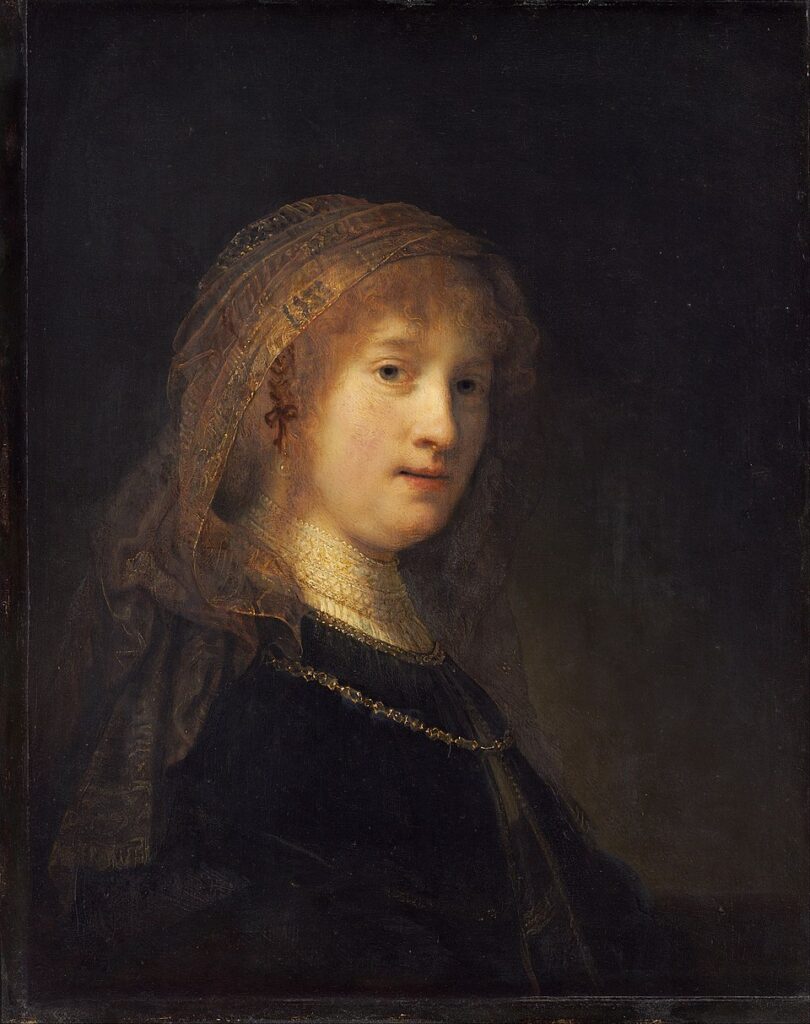
When we think of Rembrandt, the grand master of Dutch Golden Age painting, it’s easy to conjure images of dramatic chiaroscuro and poignant portraits. But behind the artist’s monumental body of work lies a deeply personal story of love, loss, and artistic inspiration. At the heart of this narrative is Saskia van Uylenburgh, Rembrandt’s first wife and the mother of his only surviving son, Titus.
Who Was Saskia van Uylenburgh?
Saskia van Uylenburgh was born on August 2, 1612, in Leeuwarden, Friesland, to a wealthy and prominent family. Her father, Rombertus van Uylenburgh, was a respected lawyer and the mayor of Leeuwarden, while her mother, Sjoukje Ozinga, came from a family of affluent landowners. Saskia was the youngest of eight children, and her upbringing was marked by privilege and education.
Tragedy struck early in Saskia’s life when her mother passed away in 1619, followed by her father in 1624. Despite these losses, Saskia remained connected to her influential family, particularly her cousin Hendrick van Uylenburgh, an art dealer based in Amsterdam. It was through Hendrick that Saskia would meet Rembrandt van Rijn, the man who would become her husband and immortalize her in his art.
The Meeting and Marriage
Rembrandt and Saskia met in 1633, likely through her cousin Hendrick’s art dealings. At the time, Rembrandt was an up-and-coming artist, gaining recognition for his unique approach to portraiture and his masterful use of light and shadow. Saskia, with her refined background and engaging personality, quickly captured the young artist’s heart.
Their courtship was relatively brief, and they became engaged on June 8, 1633. A year later, on June 22, 1634, Rembrandt and Saskia were married in the small village of Sint Annaparochie, located in Friesland. The marriage was a significant union, combining Saskia’s considerable dowry with Rembrandt’s burgeoning artistic career.
Life Together in Amsterdam
Following their marriage, Rembrandt and Saskia settled in Amsterdam, where Rembrandt’s career flourished. The couple purchased a grand house in the affluent Jodenbreestraat neighborhood, reflecting their social and financial standing. Saskia’s dowry allowed Rembrandt to establish a successful studio, where he trained numerous pupils and continued to produce his now-famous works.
Saskia’s influence on Rembrandt’s art during this period cannot be overstated. She served as a model for many of his paintings, drawings, and etchings. Some of the most renowned portraits of Saskia include “Saskia as Flora” (1635), “The Jewish Bride” (1635-1639), and the intimate etching “Saskia with a Straw Hat” (1633). These works highlight Saskia’s beauty, charm, and the deep affection Rembrandt felt for her.
Triumphs and Trials
Despite the apparent happiness and success of their early years together, Rembrandt and Saskia’s life was not without hardship. The couple faced numerous personal tragedies, particularly the loss of three of their children in infancy. Their first child, Rumbartus, was born in 1635 but died just two months later. A second child, also named Cornelia, was born in 1638 and lived only a few weeks. Another Cornelia, born in 1640, also died shortly after birth.
In 1641, Saskia gave birth to their fourth child, Titus. Unlike his siblings, Titus survived infancy, bringing immense joy and relief to his parents. However, their happiness was short-lived. Saskia’s health began to decline shortly after Titus’s birth, and she never fully recovered. She suffered from what was likely tuberculosis, a common and often fatal disease in the 17th century.
Saskia’s Death and Legacy
Saskia van Uylenburgh passed away on June 14, 1642, at the age of 29. Her death was a devastating blow to Rembrandt, both personally and professionally. In her will, Saskia left her considerable estate to Rembrandt and Titus, ensuring their financial security. However, the loss of his beloved wife marked a turning point in Rembrandt’s life and work.
Following Saskia’s death, Rembrandt’s art took on a deeper, more introspective quality. His later works, characterized by their emotional depth and psychological insight, reflect the profound impact of Saskia’s loss. Pieces like “The Night Watch” (1642), painted in the year of Saskia’s death, and his numerous self-portraits from this period, convey a sense of mourning and introspection.
Rembrandt’s Continued Influence from Saskia
Even after her death, Saskia’s presence lingered in Rembrandt’s work and life. Her portraits remained among his most cherished and frequently referenced works. He often revisited images of her, embedding her likeness in various forms across his oeuvre. This ongoing influence is evident in the tender portrayal of women in his later works, imbued with a sense of melancholy and reverence.
Rembrandt’s Later Years
After Saskia’s death, Rembrandt’s life continued to be marked by both artistic triumphs and personal challenges. He faced financial difficulties despite his success, ultimately declaring bankruptcy in 1656. These hardships did not deter his creative spirit, and he continued to produce masterpieces that delved into the human condition with unmatched depth and empathy.
In 1649, Rembrandt began a relationship with Hendrickje Stoffels, who became his companion and the mother of his second daughter, Cornelia. Despite never marrying, Hendrickje provided comfort and stability during a tumultuous period in Rembrandt’s life. Yet, the shadow of Saskia’s memory remained ever-present, a testament to her enduring impact on the artist.
Conclusion: A Love Eternal
The story of Rembrandt and Saskia van Uylenburgh is one of enduring love, profound loss, and artistic inspiration. Saskia’s presence in Rembrandt’s life and work highlights the deep connection between personal experience and creative expression. Through their time together, Rembrandt’s art flourished, capturing the essence of human emotion with unparalleled skill.
Today, as we gaze upon the portraits of Saskia and the masterpieces born from their union, we are reminded of the timeless nature of their love. Saskia’s image, immortalized in Rembrandt’s art, continues to captivate and inspire, a poignant reminder of the woman who was both muse and beloved.
In exploring the life of Saskia van Uylenburgh and her relationship with Rembrandt, we gain a deeper understanding of the man behind the art. Their story is a testament to the power of love and the enduring impact of those we hold dear, forever captured in the light and shadow of a master’s hand.




